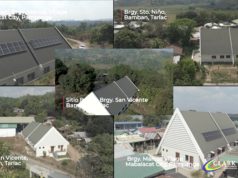LICAB, Nueva Ecija – Carabao-pulled carts, locally known as kariton, have earned the eyes of the Department of Tourism (DOT) as a new material for local tourism.
Ronnie Tiotuico, director of the DOT in Central Luzon, said the agency will help promote Kariton festival here as an annual tourism activity after watching them in a parade along the provincial road to the town proper here on Sunday.
“Naniniwala kaming magtutuloy-tuloy na itong Kariton festival dahil nasa ikatlong taon na ngayon,” Tiotuico said.
Mayor Wilfredo Domingo said that carabaos and Kariton plays a vital role for agricultural production in this municipality, some 155 kilometers north of Manila.
The carts, made mostly of hard wood and wheels, were displayed in various forms. Some of them were prepared as nipa hut that showed typical village scenes such as backyard garden and ricefield tools as the highlight of this town’s 117th foundation anniversary.
“We want to thank our founder Don Dalmacio Esguerra, patron saint of San Isidro Labrador and above all, the lord for the harvest,” Domingo said. He said that Kariton Festival, also serves as a tribute to local farmers.
“Daang taon ang nakaraan, ito ay ginagamit na sasakyan ng mga pundadores ng Licab sa kanilang paglalakbay mula sa bayan ng San Nicolas, Ilocos Norte hanggang nakarating dito na noo’y isang maliit na barrio ng Aliaga (town),” he said.
The mayor said amidst the advent of modern technology, carabaos and karitons have been essential implements of the townsfolk. “Carabaos and cart are a combination farmers can’t live without.”
Apolonio Grande, a farmer and Sangguniang Barangay (village council) member of Poblacion Norte here, said while every farmer’s dream of having a carabao, many of them simply can’t afford to buy one because of skyrocketing price of the so-called beast of burden. A working animal, he said, is now pegged at P70,000 to P80,000.
However, kariton has evolved from the traditional frame of bamboo which now became hardwood, and the wooden wheels are now those of car surplus, Grande observed.
“Talagang mahalaga ang kalabaw at kariton para sa magsasaka,” he said. His group paraded a cart covered with rice, mung beans, clam shells and other indigenous materials.
Some came in the form of “Bahay Kubo,” as pictured in the Filipino folk songs that figures almost all kinds of vegetable that can be planted in a backyard. Others have fish nets, bancas and fruits.
Female carabaos were sported with hats and accessories.
Domingo said Kariton festival, now on its third year, also comes as a tribute to farmers and thanksgiving for the “good harvest.” “This is our way of thanking our patrons and the Lord,” he said.
Ronnie Tiotuico, director of the DOT in Central Luzon, said the agency will help promote Kariton festival here as an annual tourism activity after watching them in a parade along the provincial road to the town proper here on Sunday.
“Naniniwala kaming magtutuloy-tuloy na itong Kariton festival dahil nasa ikatlong taon na ngayon,” Tiotuico said.
Mayor Wilfredo Domingo said that carabaos and Kariton plays a vital role for agricultural production in this municipality, some 155 kilometers north of Manila.
The carts, made mostly of hard wood and wheels, were displayed in various forms. Some of them were prepared as nipa hut that showed typical village scenes such as backyard garden and ricefield tools as the highlight of this town’s 117th foundation anniversary.
“We want to thank our founder Don Dalmacio Esguerra, patron saint of San Isidro Labrador and above all, the lord for the harvest,” Domingo said. He said that Kariton Festival, also serves as a tribute to local farmers.
“Daang taon ang nakaraan, ito ay ginagamit na sasakyan ng mga pundadores ng Licab sa kanilang paglalakbay mula sa bayan ng San Nicolas, Ilocos Norte hanggang nakarating dito na noo’y isang maliit na barrio ng Aliaga (town),” he said.
The mayor said amidst the advent of modern technology, carabaos and karitons have been essential implements of the townsfolk. “Carabaos and cart are a combination farmers can’t live without.”
Apolonio Grande, a farmer and Sangguniang Barangay (village council) member of Poblacion Norte here, said while every farmer’s dream of having a carabao, many of them simply can’t afford to buy one because of skyrocketing price of the so-called beast of burden. A working animal, he said, is now pegged at P70,000 to P80,000.
However, kariton has evolved from the traditional frame of bamboo which now became hardwood, and the wooden wheels are now those of car surplus, Grande observed.
“Talagang mahalaga ang kalabaw at kariton para sa magsasaka,” he said. His group paraded a cart covered with rice, mung beans, clam shells and other indigenous materials.
Some came in the form of “Bahay Kubo,” as pictured in the Filipino folk songs that figures almost all kinds of vegetable that can be planted in a backyard. Others have fish nets, bancas and fruits.
Female carabaos were sported with hats and accessories.
Domingo said Kariton festival, now on its third year, also comes as a tribute to farmers and thanksgiving for the “good harvest.” “This is our way of thanking our patrons and the Lord,” he said.




